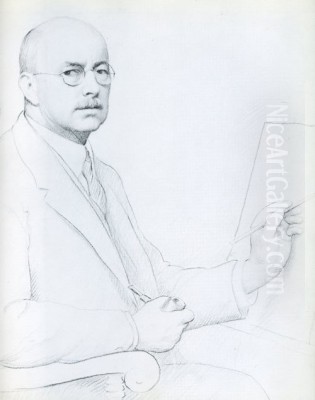
William McGregor Paxton stands as a significant figure in American art history, renowned for his contributions to Impressionism and Realism during the late nineteenth and early twentieth centuries. Born in Boston, Massachusetts, on June 22, 1869, Paxton's life and career were deeply intertwined with the artistic milieu of his native city, though his influence extended far beyond. His work, characterized by technical brilliance and a sensitive portrayal of light and subject matter, continues to be celebrated. Paxton passed away in 1941 at the age of 72, leaving behind a rich legacy.
Early Life and Artistic Formation
Paxton's journey into the world of art began formally at the age of eighteen. Having moved with his family from Boston to the nearby community of Newton Corner, he secured a scholarship to attend the prestigious Cowles Art School in Boston. This initial training provided him with a solid foundation in drawing and painting. Among his early instructors at Cowles was Dennis Miller Bunker, a key figure in the Boston art scene whose teachings would leave an impression on the young artist.
Seeking to broaden his artistic horizons, Paxton traveled to Paris, the epicenter of the art world at the time. There, he pursued further studies under the tutelage of the acclaimed French academic painter Jean-Léon Gérôme at the École des Beaux-Arts. Gérôme, known for his meticulous detail and historical subjects, instilled in Paxton a deep respect for draftsmanship and classical composition, skills that would underpin his work throughout his career. This period in Paris exposed Paxton to both rigorous academic traditions and the burgeoning Impressionist movement.
Upon returning to Boston, Paxton continued his studies, reconnecting with the Cowles Art School. He further refined his skills under Joseph DeCamp, another prominent Boston painter who became an important mentor. DeCamp, along with other Boston artists, was instrumental in shaping the artistic direction that Paxton would ultimately pursue, blending academic precision with the fresh perspectives of Impressionism.
The Boston School and Artistic Circle
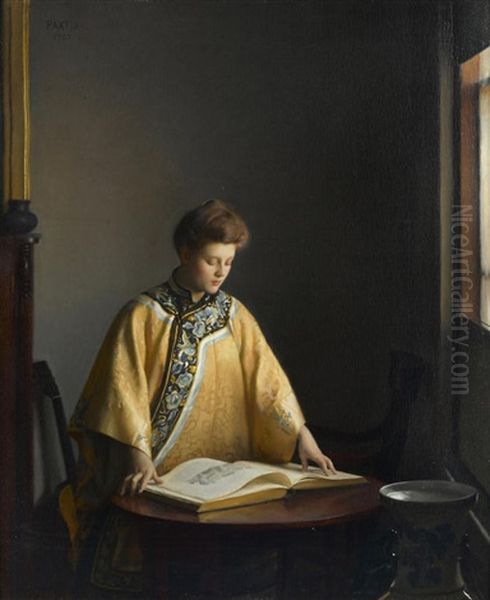
William McGregor Paxton became a central figure in what is known as the Boston School of painting. This group, active primarily in the late 19th and early 20th centuries, was not a formal institution but rather a cohesive circle of artists who shared stylistic affinities and often trained together. They were known for their commitment to academic draftsmanship combined with the Impressionistic concern for light and color, often applied to refined subject matter.
Paxton was not merely a participant but a leader within this movement. He was a co-founder of The Guild of Boston Artists, an organization established in 1914 to promote the work of traditionally-minded painters and sculptors in the face of rising modernism. His close associates and fellow core members of the Boston School included Edmund Charles Tarbell and Frank Weston Benson, both highly respected painters and influential teachers, as well as his former mentor, Joseph DeCamp. Together, these artists defined a distinct regional style characterized by technical skill and aesthetic elegance.
The Boston art scene during Paxton's active years was vibrant. While closely associated with Tarbell, Benson, and DeCamp, Paxton's career also intersected with the broader artistic community. Figures like the famed portraitist John Singer Sargent, although more internationally focused, were influential presences in Boston. Paxton also shared the exhibition spaces with contemporaries such as Norman Rockwell and Peter Wagner, reflecting the diverse artistic activities occurring in the city during this period.
Artistic Style and Influences
Paxton's artistic style is a sophisticated blend of academic realism and Impressionist sensibility. His training under Jean-Léon Gérôme provided him with a strong foundation in drawing and composition, evident in the structural integrity of his works. However, he moved beyond strict academicism, embracing the Impressionist fascination with light and its effects.
A profound influence on Paxton's work was the Dutch Golden Age master Johannes Vermeer. Paxton deeply admired Vermeer's handling of light, his serene interior scenes, and his meticulous attention to detail and texture. This influence is palpable in Paxton's own depictions of tranquil domestic spaces, often illuminated by window light, and his careful rendering of fabrics, surfaces, and objects within the scene.
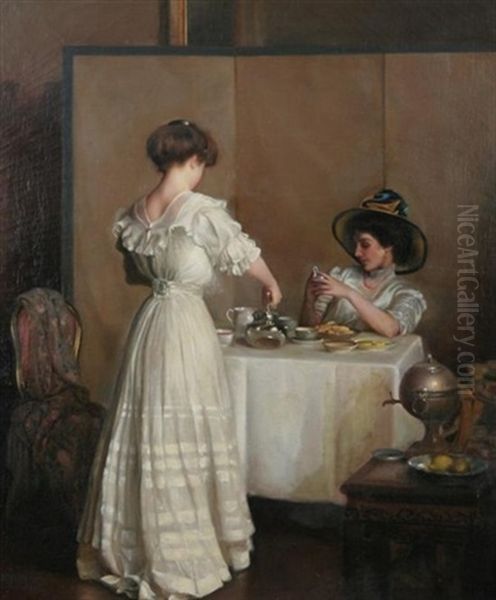
Paxton developed a particular technique, sometimes referred to as "binocular vision," inspired by his study of Vermeer and optical principles. This involved rendering the focal point of the painting with sharp clarity while allowing the peripheral areas to remain softer and slightly blurred. This mimics natural human vision, directing the viewer's eye and enhancing the sense of realism and depth. This technique, though perhaps misunderstood by some initially, became a hallmark of his mature style, particularly evident in works like The New Necklace.
His paintings are characterized by delicate brushwork, a refined color palette, and an exceptional ability to capture the play of light and shadow. He was also noted for incorporating elements of Japonisme or an interest in Oriental aesthetics, sometimes including porcelain or specific textiles in his compositions, reflecting a broader trend in Western art at the time.
Themes and Subject Matter
The predominant subjects in William McGregor Paxton's oeuvre are portraits and interior scenes, often featuring elegant women. His depictions typically portray women engaged in quiet activities within refined domestic settings – reading, sewing, arranging flowers, or lost in thought. These scenes often evoke a sense of tranquility, introspection, and idealized femininity, reflecting the tastes and social norms of his upper-class Boston patrons.
His interior scenes are meticulously composed, showcasing his skill in rendering textures, fabrics, and the subtle interplay of light filtering through windows or emanating from lamps. These environments are not mere backdrops but integral parts of the composition, contributing to the overall mood and narrative suggestion. While often beautiful and serene, his works can possess a subtle psychological depth or a hint of narrative ambiguity, inviting the viewer to contemplate the subject's inner world.
Paxton was also a highly sought-after portrait painter. His ability to capture a likeness while imbuing the subject with grace and dignity made him popular among Boston's elite. His notable commissions included portraits of prominent figures, including two U.S. Presidents, Grover Cleveland and Calvin Coolidge. This success in portraiture earned him the informal title of "court painter of Boston," signifying his status within the city's social and artistic hierarchy.
Representative Works
Several paintings stand out as exemplary of Paxton's style and thematic concerns. The New Necklace (1910) is perhaps one of his most famous works, perfectly illustrating his "binocular vision" technique. In this painting, the central elements – the woman's hands and the necklace she examines – are rendered with sharp focus, while the surrounding areas, including her face and the background, are softer, drawing the viewer directly to the intimate action.
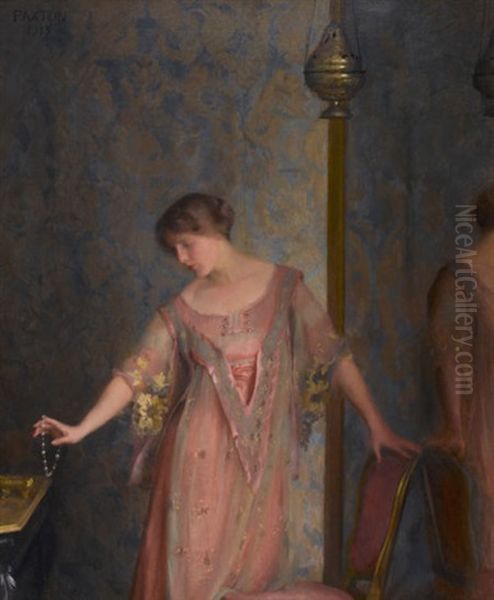
The Yellow Jacket (c. 1907) depicts a woman absorbed in reading, seated in a well-appointed interior. The painting showcases Paxton's skill in capturing the textures of fabric – the titular yellow jacket – and the play of light across the room, creating a warm and intimate atmosphere. Similarly, Tea Leaves (1909) presents an elegant woman in profile, contemplating tea leaves in a cup, a moment of quiet reflection rendered with characteristic sensitivity to light and mood, reflecting the leisurely pursuits of the era.
The Maid in the Room, also known as The House Maid (c. 1910), is another significant work. It gained recognition when exhibited at the Pennsylvania Academy of the Fine Arts in 1911. This painting, depicting a domestic worker in an interior setting, demonstrates Paxton's ability to apply his refined technique to varied subjects within the domestic sphere. The Morning Paper captures a similar intimate moment, portraying a woman reading a newspaper in a warmly lit interior, imbued with a sense of quiet domesticity and emotion. Rose and Blue is another notable work, recognized both in exhibitions and for its performance in the art market.
Career as Educator and Professional Life
Beyond his prolific output as a painter, William McGregor Paxton made significant contributions as an art educator. He taught at the School of the Museum of Fine Arts, Boston, for a significant period, specifically documented between 1906 and 1913 (though some accounts suggest a longer tenure). His teaching philosophy emphasized rigorous practice and a deep understanding of the fundamentals: form, structure, light, shadow, and color.
His influence extended to a generation of artists who studied under him. One of his most notable students was R.H. Ives Gammell, who himself became a prominent painter and teacher, carrying forward the traditions of the Boston School. Paxton's role as an educator solidified his position as a central figure in the Boston art establishment.
Paxton's professional activities were diverse. In addition to his easel paintings, he undertook commissions as a muralist, creating works for institutions such as the Army and Navy Club in New York and the St. Botolph Club in Boston. He also practiced printmaking, working as an etcher. His multifaceted career saw him achieve significant professional recognition; in 1928, he was elected a full member of the prestigious National Academy of Design in New York. His co-founding of the Guild of Boston Artists further demonstrated his commitment to supporting and shaping the artistic landscape of his time.
Exhibitions and Recognition
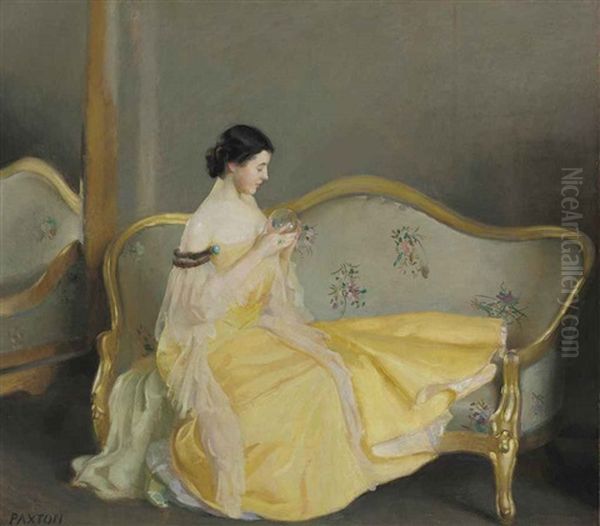
Throughout his career and posthumously, William McGregor Paxton's work has been featured in numerous important exhibitions across the United States and internationally. His paintings are held in the permanent collections of major institutions, including the Museum of Fine Arts, Boston; the Metropolitan Museum of Art, New York; the Smithsonian American Art Museum; and the Maryhill Museum of Art, among others.
Significant exhibitions dedicated to his work have helped solidify his reputation. In 1944, three years after his death, the Museum of Fine Arts, Boston, mounted a memorial exhibition that included not only finished paintings but also drawings, sketches, letters, and papers, offering insight into his working process. Vose Galleries of Boston, long associated with the Boston School, held the first major exhibition drawn from the artist's estate in 1976, featuring a selection of oils and drawings.
His paintings continue to be included in group shows exploring American Impressionism and the Boston School. For instance, his work Rose and Blue was exhibited at the Indianapolis Museum of Art in 2009. Recognition also came through prestigious venues like the Pennsylvania Academy of the Fine Arts, where The House Maid was notably shown in 1911. His election to the National Academy of Design in 1928 stands as a testament to the high regard in which he was held by his peers.
Market Presence
William McGregor Paxton's paintings have maintained a consistent presence in the art market, appreciated by collectors of American Impressionism and Realism. His works appear regularly at major auction houses. The prices achieved reflect his established reputation and the enduring appeal of his refined style and subject matter.
A notable example of his market performance is the sale of Rose and Blue. After being exhibited at the Indianapolis Museum of Art, the painting was sold at Heritage Auctions in June 2009 for $209,125, indicating significant collector interest. Other major works, such as The Yellow Jacket, have also come up for auction, demonstrating the continued desirability of his paintings. The market recognizes the quality, technical skill, and historical importance associated with Paxton's name.
Later Life and Legacy
William McGregor Paxton remained active as an artist until the end of his life. Tragically, his life concluded abruptly. In 1941, while at his home studio painting a portrait of his wife, Elizabeth Okie Paxton (who was also a painter), he suffered a fatal heart attack. He was 72 years old.
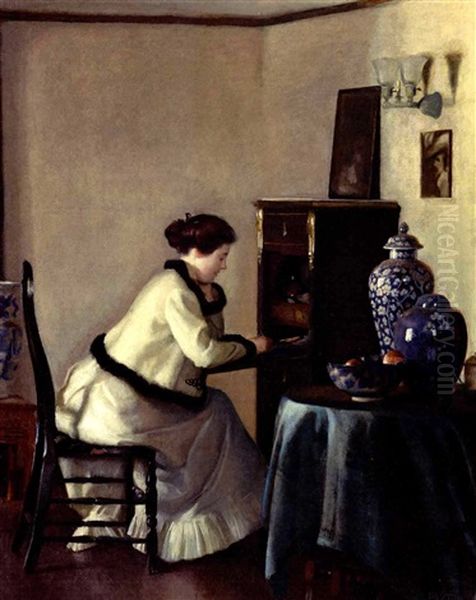
Paxton's legacy is that of a master craftsman and a key exponent of the Boston School tradition. He successfully navigated the artistic currents of his time, adapting Impressionist techniques to a fundamentally realist and academic framework. His dedication to beauty, technical excellence, and the sensitive depiction of light and form secured his place in American art history.
His influence persisted through his own work and through the students he taught, such as R.H. Ives Gammell, who continued the lineage of classical realism. Paxton's paintings remain admired for their elegance, technical virtuosity, and evocative portrayal of a specific time and social milieu in American history. He stands as a vital link between 19th-century academic traditions and 20th-century American realism.
Relationship with Contemporaries
While William McGregor Paxton was deeply embedded in the Boston School alongside Edmund Charles Tarbell, Frank Weston Benson, and Joseph DeCamp, his relationship with other major figures like John Singer Sargent is less documented in terms of direct personal interaction, based on available records. However, they operated within the same artistic environment and shared certain influences.
Both Paxton and Sargent were influenced by the Old Masters, including Vermeer, and both achieved great success as portraitists within Boston's elite circles. Paxton's teacher, Dennis Miller Bunker, was notably a friend of Sargent, providing an indirect link between the two painters. Bunker's own style, which blended Impressionist brushwork with solid form, likely resonated with both artists and certainly influenced Paxton directly.
Although specific records of joint activities or close collaboration between Paxton and Sargent within the Boston School context might be scarce, their parallel careers, shared influences (like Vermeer), and mutual connections (like Bunker) suggest they were certainly aware of each other's work and likely moved within overlapping professional circles. Paxton's primary collaborators and artistic confidantes, however, remained his fellow core members of the Boston School: Tarbell, Benson, and DeCamp.